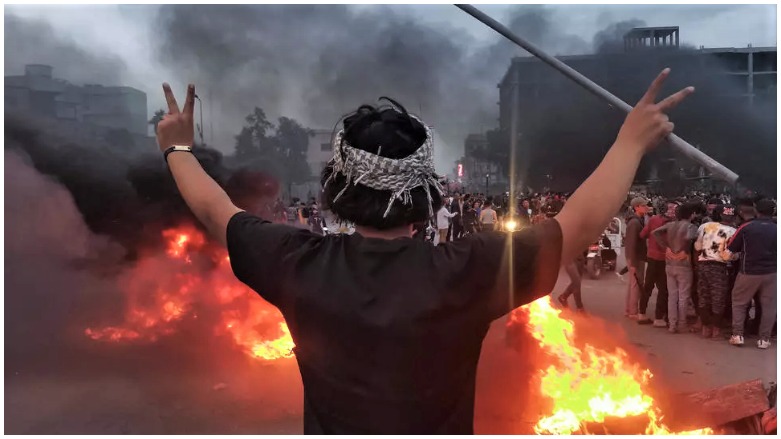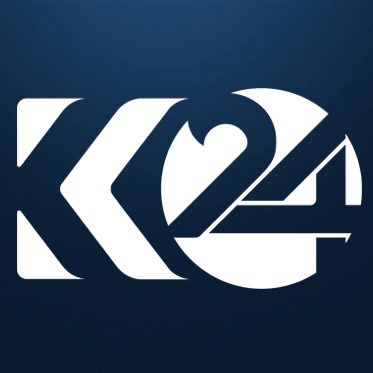Protesters killed, wounded in southern Iraq by Sadr followers

ERBIL (Kurdistan 24) – As many as seven protestors have been killed and several others wounded since Friday after armed supporters of firebrand Iraqi cleric Muqtada al-Sadr attacked those taking part in ongoing anti-government demonstrations in the southern city of Nasiriya.
It began late Friday when crowds of armed Sadrists descended on the protesters and torched tents they had set up in their main gathering place at Nasiriya’s Habboubi Square, killing or wounding several of them.
This led Iraqi Prime Minister Mustafa al-Kadhimi to declare a curfew in Dhi Qar province, dismiss the local police chief, and form a committee to investigate the incident.
However, on Saturday, tensions erupted again when anti-government protestors took the streets to block the path of approaching pro-Sadr protestors.
Sadr had previously called on his followers to “hit the streets in a show of force on Friday in support of their leader's call for mass participation in next year's national elections,” reported AP. As a result, tens of thousands of them took the streets in the capital Baghdad and other cities.
Muqtada al-Sadr tells protesters to go home and for the government to do what’s necessary to keep security and deal with them, after his supporters began clashes that have killed at least 7 demonstrators in Nassiriya #iraq https://t.co/G5Dyxa2ezT
— John Davison (@JohnDrtrs) November 28, 2020
On Saturday, Muqtada al-Sadr called on anti-government protestors to go and for the government “to do what’s necessary to keep the security and deal with the protestors.”
Speaking to Kurdistan 24, an analyst on Iraqi affairs and author of the Musings on Iraq blog Joel Wing emphasized that “Sadr wanted a show of his power before the 2021 elections and called for his followers to come out in several Iraqi cities.”
“In Nasiriya, Dhi Qar they attacked the protest camp there as a message to the activists that they should stop. The protests are pushing the same issues as the Sadrists such as fighting corruption and ending foreign influence which could cut into his support.”
Nasiriyah was a major hub for the protest movement that erupted in October 2019 against government corruption, poor services, and a low standard of living. Since then, hundreds have been killed and tens of thousands wounded.
In late November 2019, dozens of protesters were killed when riot police opened fire on the crowd, some of the protest-related casualties that eventually results in the resignation of then-prime minister Adil Abdul Mahdi and his cabinet.
On Saturday evening, the massive crowd left Habboubi Square in a memorial march to honor those who lost their lives a year ago, carrying symbolic coffins as they made their way to Zeitoun Bridge, AFP reported.
Some protestors compared Mahdi to his successor, Kadhimi, after the latest violence, the AFP reported. He has set June 2021 as the date for early elections to appease protestors' demands.
#Iraqi anti-government protesters hit the streets again in #Nasiriyah’s Haboubi square, as results for a protest camp was attacked by supporters of the influential Shia cleric Al-Sadr.
— Ehab Al Obaidy (@Ehab8Alobaidy) November 28, 2020
The protesters chanting slogans against Muqtada Al-#Sadr.#Iraqprotest pic.twitter.com/IhOFRHIXig
It's not the first time Sadr's armed supporters, often called “Blue caps” by government protestors, have used violence at the demonstrations.
In February, a brutal crackdown they carried out against protesters in the southern city of Najaf resulted in the deaths of at least eight and as many as 100 wounded.
Kirk H. Sowell, the principal of Middle East-focused political risk firm Utica Risk Services, told Kurdistan 24 that Sadr’s more hostile position towards protestors goes back to January and February, not long after a meeting of representatives of Tehran-backed militias was held in Iran.
The groups met to unite on the decision to expel American forces from Iraq. This came after the Iraqi parliament held an extraordinary session on Jan. 5 to vote on a non-binding resolution for the Iraqi government to expel foreign military troops in Iraq.
“There was a meeting in Qom; Sadr, Amiri, other Iran-aligned groups, and they stopped fighting one another. Right after that, the “Blue Cap” phenomenon arose; these were like enforcers, and Sadr abolished them in February after I presume he realized they were drawing too much attention to his thuggery,” he said.
However, the tensions continued and pro-Sadr groups continued to attack anti-government protestors.
Sowell said, “My view is that Sadr decided that the strength of the fall 2019 protests was such that he couldn't co-opt or manipulate them, so he had to crush them.”
“From 2015-2018, you may remember Sadr was working with protesters, or at least some protest groups, most notably the ICP (Iraqi Communist Party). But the Sadrists and the ICP split in 2019. They all saw the writing on the wall.”
Sadr has been an unpredictable character, and as demonstrations continued, he switched his position in his support for the movement back and forth multiple times, with some protesters considering him a cynical politician who attempted to steer the crowds to his benefit.
The Associated Press reported that anti-government protesters feel betrayed by al-Sadr’s flip-flop approach toward them, especially in the last few months when he withdrew support for their movement.
Editing by John J. Catherine and Khrush Najari
